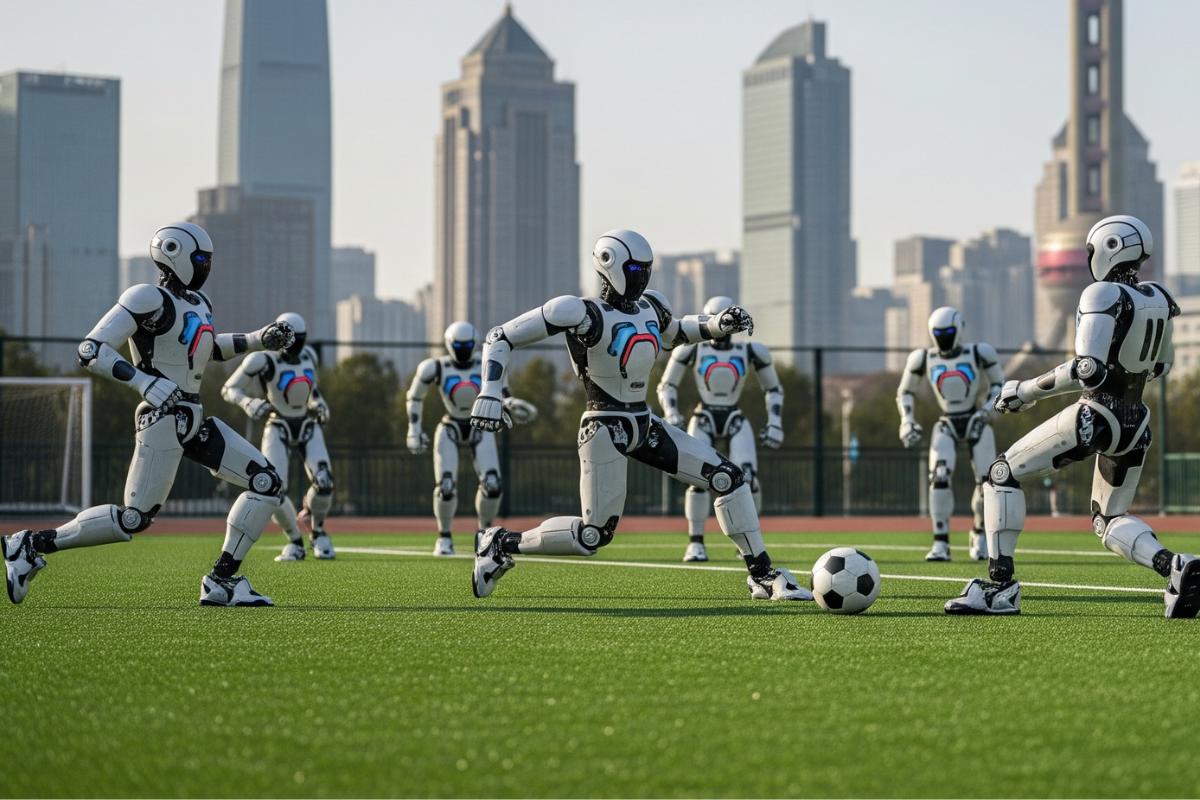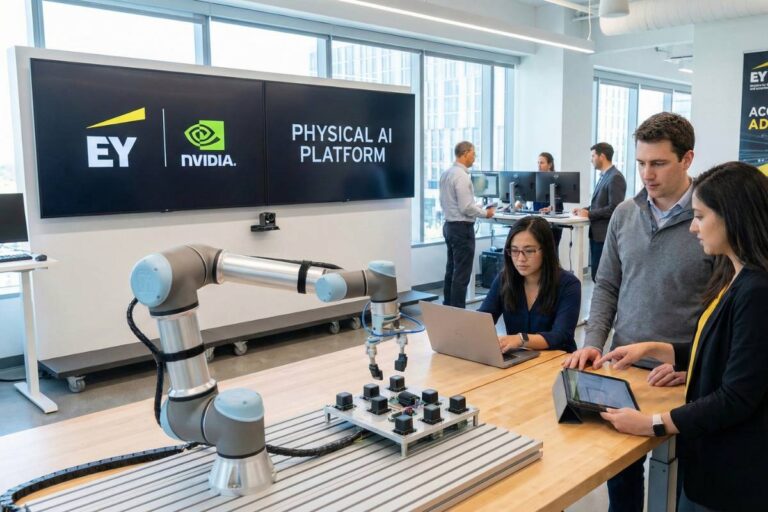What a big change! On a sunny soccer field in Beijing, a group of humanoid robots stood still and blinked. They did something that had never been done before: they had a soccer game with robots that could think for themselves. There was no sign of a remote control. There isn’t a coach yelling from the sidelines. Just algorithms, sensors, and some surprisingly steady and sometimes shaky footwork.
That’s only the beginning. This wasn’t just a neat new thing. China is leading the way in figuring out how robots and AI will soon change everything from sports to solving problems in the real world.
Let’s talk about the show, the story behind the march to the field, and the bigger race in robotic innovation that is now openly competing for global leadership.
Game Day in Beijing: What Happened?
It all started out very simply. Four teams, each with three robots, lined up on a well-kept field in Beijing for what reporters and fans quickly called a first-of-its-kind event. How about the robots? They had cameras, microphones, and AI that would make Roombas from the past jealous.
There were a lot of fans in the stands. There was a lot of excitement in the air, but there was also some doubt. The robots did move like little, determined toddlers learning to walk, but they were the only ones who could kick, dribble, or try to get back up after falling. They didn’t have any human hands to help them. Each robot’s “mind” made all of its decisions, including when to pass, shoot, move, and recover. This was done by writing lines of code that got better after hours of practice.
Sometimes robots fell over and had to be carried away on stretchers. Robots can be dramatic too. Still, they got back up and kept playing.
Robots That Compete: How They Work
So what powered these metallic newcomers? Here’s the core:
- Full Autonomy: No humans behind the curtain. Robots operated fully independently, making on-the-fly decisions thanks to sophisticated, real-time AI.
- Sensors as “Senses”: Cameras and other sensors served as the robots’ “eyes,” identifying the ball, teammates, and rivals. Audio sensors sometimes picked up crowd noise to test stability.
- Learning from Us: The robots used advanced techniques like imitation learning, first observing human soccer play, then repeating movements in virtual simulators tens of thousands of times to internalize what works and what doesn’t.
- Adapting Fast: Software allowed for quick “muscle memory.” If a robot fell, it was programmed to get up, sometimes smoothly, sometimes with comic wobbiness.
The Human Touch: Student Engineers and Their Algorithms
Perhaps the most impressive twist: these robotic soccer teams didn’t spring forth fully formed from a top-secret factory. Instead, the real stars behind the performance were student teams from China’s top universities.
- Fresh Talent: Engineering students developed their teams’ algorithms and tactical strategies. Their main goal? Make the robots not only move, but also cooperate, passing, anticipating, and strategizing as if they were real teammates.
- Battle of the Brains: This kind of coding competition, where teams can see each other’s approaches, helps raise the bar across the entire field.
One student summed it up: “We’re excited not just to compete but to show the new learning algorithms we developed, watching how the robot masters dribbling and shooting is its reward.”
Made in China: Strategic Goals and National Ambition
This soccer match wasn’t just a bit of fun; it’s the literal embodiment (pun intended) of China’s push to become a powerhouse in robotics and AI.
National Stakes
- China’s government has been loudly promoting “embodied AI”, the use of AI in robots designed for complex, real-world tasks.
- Events like these are part of a drive to ensure the country’s future dominance in sophisticated, high-tech manufacturing and robotics.
- For companies, this is not just about winning matches; it’s about positioning themselves for a piece of a multi-billion-dollar industry.
As one leading analyst noted, “The scale and speed of China’s support for robotics R&D is probably unmatched right now. We may be watching a new standard being set, one that could force other nations, especially the US, to take notice.”
Not Just Soccer: The World Humanoid Robot Games
Turns out, this match was just a warm-up. The event was organized as a preview for the inaugural World Humanoid Robot Games, scheduled for Beijing in mid-August.
- Twenty-nation tournament: Teams from over twenty countries have registered to compete in a range of sports, not just soccer. Gymnastics, athletics, martial arts, and even tasks related to healthcare and industrial work will be tested.
- Testing Grounds: These games are being seen as both a symbol of technological prowess and a practical “sandbox.” What works on the field, engineers say, could soon find its way into workplaces and homes.
Tech, Trial, and Error: Behind the Robo-Skills
Perfect soccer isn’t the point, at least for now. The abilities on show were very much a work in progress, part science experiment, part talent showcase. Here’s the kicker: while some robots could dribble and shoot with surprising accuracy, others stumbled over simple obstacles or even over each other.
Still, watching tiny robot “goalies” pump their fists after a rare save, or teammates try (and sometimes fail) to pass the ball, spectators found themselves both amused and amazed.
The underlying tech was something else:
- Deep Reinforcement Learning: This AI method lets robots “try, fail, and learn”, simulating endless matches so they improve every time.
- Collaborative Coding: Much of the breakthrough came from adapting existing software, particularly from Chinese competitors’ strong performances at international robot competitions like the RoboCup in Brazil.
Why Does It Matter? Global Robotics Rivalry
Funny thing is, China isn’t shy about why it’s doing all this. The message? Humanoid robots will play a massive part in industry, healthcare, and maybe even everyday life, and the country that masters these technologies first will have a real edge.
- International Rivals: Critics online point out that China’s claim to “the first autonomous 3-on-3 robot soccer match” is debatable. RoboCup contests in Europe and Australia did similar things years back. Still, few have matched the scale, national backing, or public spectacle of Beijing’s event.
- Showcase vs. Substance: Yes, some say it’s publicity. But each robot’s ability to “sense” its environment and make fast decisions on a crowded field is a big deal.
Where the Technology Stands, And Where It Stumbles
Let’s not kid ourselves. The robots aren’t about to give Lionel Messi a run for his money. Here’s what they did well, and where they still have miles to go:
Strengths
- Self-reliance: No human intervention, even for falls.
- Robust design: Able to withstand pushes, falls, and the odd “injury.”
- Impressive balance: Some managed rapid turns, quick stops, and even complex “passes.”
Weaknesses
- Slow motion: For now, the action is more slow-motion replay than World Cup highlight.
- Awkwardness: Balance and dexterity limits remain obvious; robots stumbled, collided, and occasionally lost the ball entirely.
- Vulnerability: Factors like the pitch surface, slope, and crowd noise can derail a team’s performance.
As one expert put it: “There’s still a big gap between robots and humans. But with each match, that gap narrows a little.”
Glimpses of Tomorrow: Real-World Uses on the Horizon
Kind of wild to think about, but testing robots on a soccer field does more than entertain. It acts as a laboratory for AI that, someday, could shape how we live and work:
- Manufacturing: Robots that cooperate, dodge obstacles, and recover from mistakes can revolutionize assembly lines.
- Healthcare: Imagine robots that, thanks to developments from these games, can maneuver safely in hospitals or homes, assisting the elderly or disabled.
- Everyday Life: From home helpers to delivery bots, the ability to sense surroundings, make decisions, and recover from stumbles is essential.
Beyond the Match: Closing Thoughts
So what did China’s first all-robot soccer match accomplish? More than a few laughs, definitely more than a viral clip.
It signaled a new phase in the global robotics race, with China putting its ambitions, talent, and tech on very public display.It will be years, maybe even decades, before robots start to bother pro athletes. But what can we learn from this? Sometimes, progress looks like toddler robots following a ball. At first, they are unsure, but then they make history step by step.
















